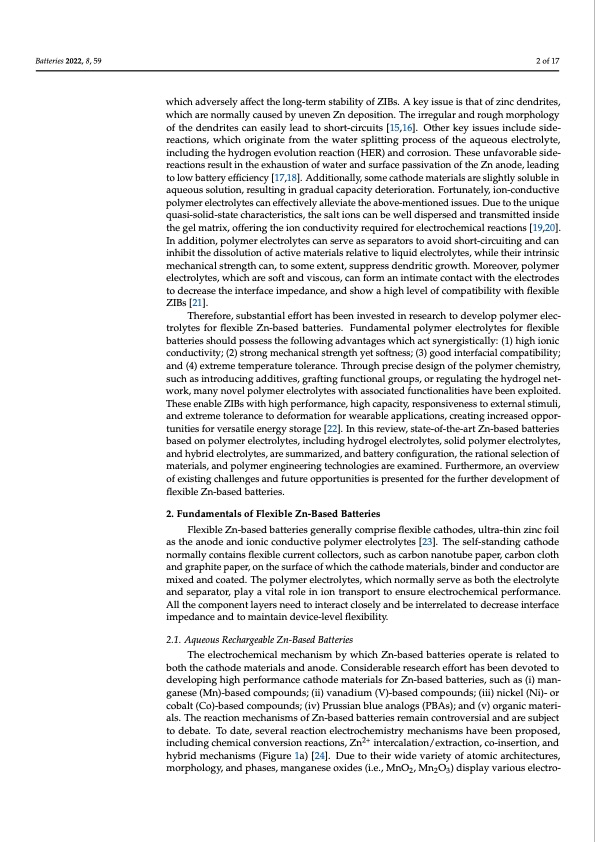
PDF Publication Title:
Text from PDF Page: 002
Batteries 2022, 8, 59 2 of 17 which adversely affect the long-term stability of ZIBs. A key issue is that of zinc dendrites, which are normally caused by uneven Zn deposition. The irregular and rough morphology of the dendrites can easily lead to short-circuits [15,16]. Other key issues include side- reactions, which originate from the water splitting process of the aqueous electrolyte, including the hydrogen evolution reaction (HER) and corrosion. These unfavorable side- reactions result in the exhaustion of water and surface passivation of the Zn anode, leading to low battery efficiency [17,18]. Additionally, some cathode materials are slightly soluble in aqueous solution, resulting in gradual capacity deterioration. Fortunately, ion-conductive polymer electrolytes can effectively alleviate the above-mentioned issues. Due to the unique quasi-solid-state characteristics, the salt ions can be well dispersed and transmitted inside the gel matrix, offering the ion conductivity required for electrochemical reactions [19,20]. In addition, polymer electrolytes can serve as separators to avoid short-circuiting and can inhibit the dissolution of active materials relative to liquid electrolytes, while their intrinsic mechanical strength can, to some extent, suppress dendritic growth. Moreover, polymer electrolytes, which are soft and viscous, can form an intimate contact with the electrodes to decrease the interface impedance, and show a high level of compatibility with flexible ZIBs [21]. Therefore, substantial effort has been invested in research to develop polymer elec- trolytes for flexible Zn-based batteries. Fundamental polymer electrolytes for flexible batteries should possess the following advantages which act synergistically: (1) high ionic conductivity; (2) strong mechanical strength yet softness; (3) good interfacial compatibility; and (4) extreme temperature tolerance. Through precise design of the polymer chemistry, such as introducing additives, grafting functional groups, or regulating the hydrogel net- work, many novel polymer electrolytes with associated functionalities have been exploited. These enable ZIBs with high performance, high capacity, responsiveness to external stimuli, and extreme tolerance to deformation for wearable applications, creating increased oppor- tunities for versatile energy storage [22]. In this review, state-of-the-art Zn-based batteries based on polymer electrolytes, including hydrogel electrolytes, solid polymer electrolytes, and hybrid electrolytes, are summarized, and battery configuration, the rational selection of materials, and polymer engineering technologies are examined. Furthermore, an overview of existing challenges and future opportunities is presented for the further development of flexible Zn-based batteries. 2. Fundamentals of Flexible Zn-Based Batteries Flexible Zn-based batteries generally comprise flexible cathodes, ultra-thin zinc foil as the anode and ionic conductive polymer electrolytes [23]. The self-standing cathode normally contains flexible current collectors, such as carbon nanotube paper, carbon cloth and graphite paper, on the surface of which the cathode materials, binder and conductor are mixed and coated. The polymer electrolytes, which normally serve as both the electrolyte and separator, play a vital role in ion transport to ensure electrochemical performance. All the component layers need to interact closely and be interrelated to decrease interface impedance and to maintain device-level flexibility. 2.1. Aqueous Rechargeable Zn-Based Batteries The electrochemical mechanism by which Zn-based batteries operate is related to both the cathode materials and anode. Considerable research effort has been devoted to developing high performance cathode materials for Zn-based batteries, such as (i) man- ganese (Mn)-based compounds; (ii) vanadium (V)-based compounds; (iii) nickel (Ni)- or cobalt (Co)-based compounds; (iv) Prussian blue analogs (PBAs); and (v) organic materi- als. The reaction mechanisms of Zn-based batteries remain controversial and are subject to debate. To date, several reaction electrochemistry mechanisms have been proposed, including chemical conversion reactions, Zn2+ intercalation/extraction, co-insertion, and hybrid mechanisms (Figure 1a) [24]. Due to their wide variety of atomic architectures, morphology, and phases, manganese oxides (i.e., MnO2, Mn2O3) display various electro-PDF Image | Flexible Zn-Based Batteries with Polymer Electrolyte

PDF Search Title:
Flexible Zn-Based Batteries with Polymer ElectrolyteOriginal File Name Searched:
batteries-08-00059.pdfDIY PDF Search: Google It | Yahoo | Bing
Product and Development Focus for Salgenx
Redox Flow Battery Technology: With the advent of the new USA tax credits for producing and selling batteries ($35/kW) we are focussing on a simple flow battery using shipping containers as the modular electrolyte storage units with tax credits up to $140,000 per system. Our main focus is on the salt battery. This battery can be used for both thermal and electrical storage applications. We call it the Cogeneration Battery or Cogen Battery. One project is converting salt (brine) based water conditioners to simultaneously produce power. In addition, there are many opportunities to extract Lithium from brine (salt lakes, groundwater, and producer water).Salt water or brine are huge sources for lithium. Most of the worlds lithium is acquired from a brine source. It's even in seawater in a low concentration. Brine is also a byproduct of huge powerplants, which can now use that as an electrolyte and a huge flow battery (which allows storage at the source).We welcome any business and equipment inquiries, as well as licensing our flow battery manufacturing.| CONTACT TEL: 608-238-6001 Email: greg@salgenx.com | RSS | AMP |